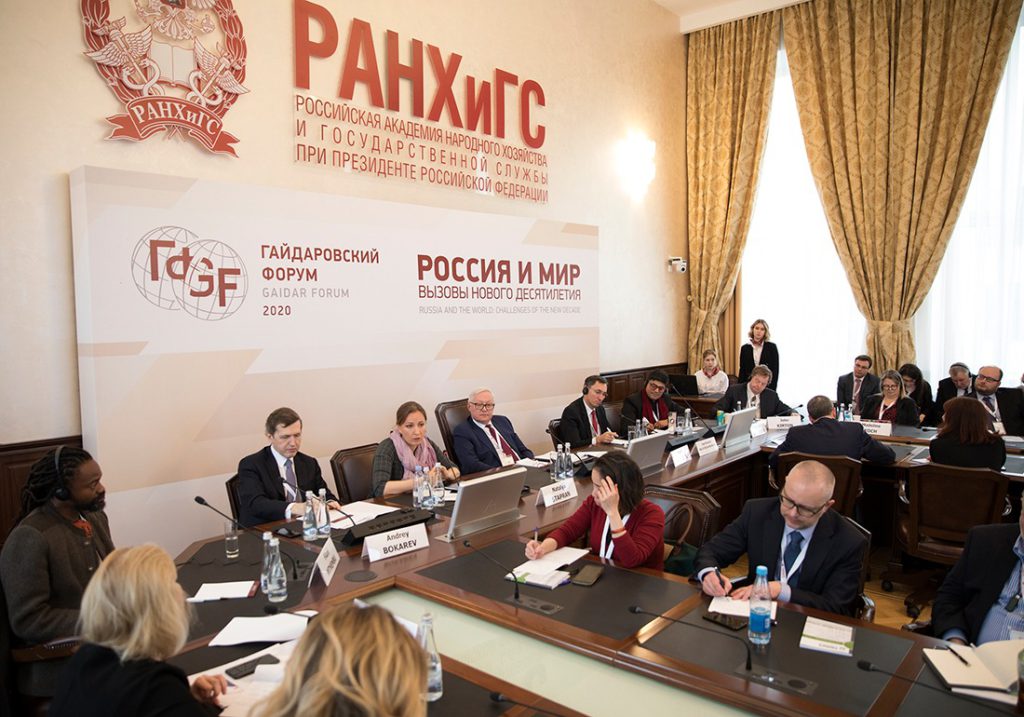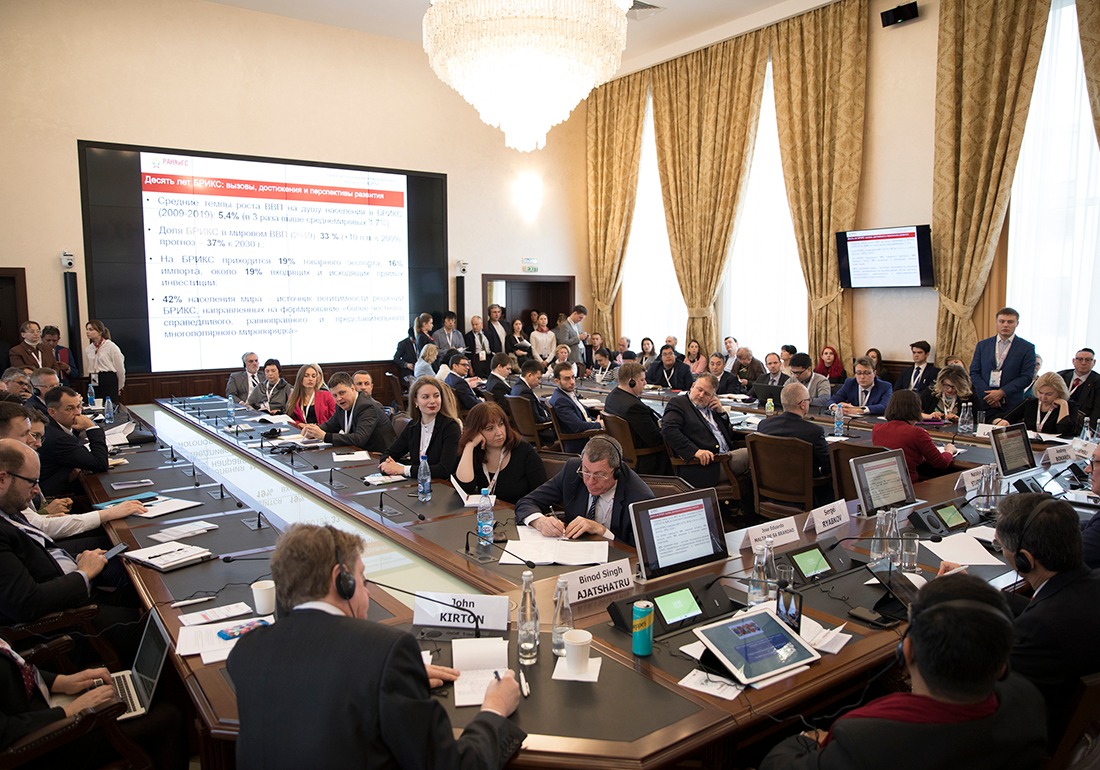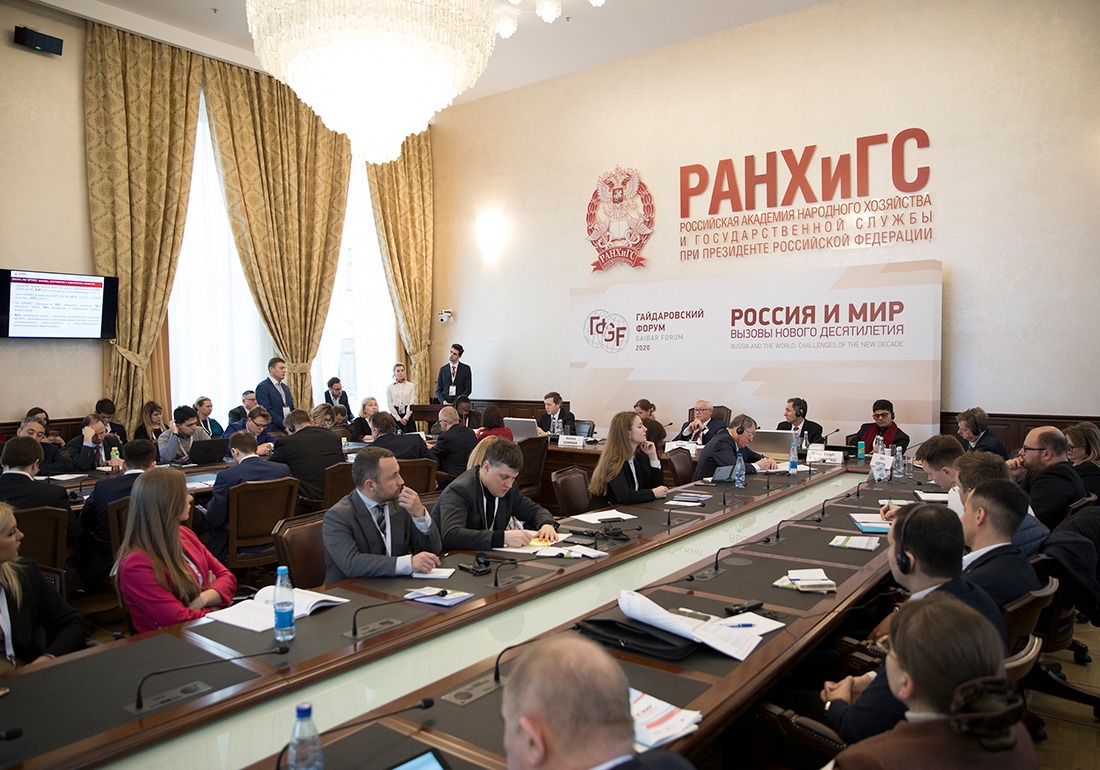[Analytics] BRICS the matter: Cementing role of the Eurasian integration in the next decade

Experts' discussion at the 11th Gaidar Forum "BRICS at ten: challenges, achievements and prospects." Photo: RANEPA press service. Moscow, Jan 15, 2020. | Дискуссия экспертов на сессии "Десять лет БРИКС: вызовы, достижения и перспективы развития". Фото: Пресс-служба РАНХиГС. 15 января 2020 года, Москва.
At first glance, there is no connection between two events, that started the Raging Twenties. Jan 1, the chairmanship of the BRICS group passed from Brazil to Russia. Jan 3, a US drone strike killed Iranian key general Qasem Soleimani, the entire Mideast was near a huge hit. The geopolitics’ axis of the next decade is a Eurasian integration of the three major nodes: China, Russia and Iran, and the US counteracting to it. Dmitrii Shcherbakov specially for the Pan Pacific Agency from the 11th Gaidar Forum.
During the last global economic crisis (2009), when the informal union of developing countries, later called BRICS, was just born, columnist Nouriel Roubini wrote in Forbes: “Analysts speaking again of the “decoupling” theory, according to which some parts of Europe and Asia are detaching themselves from the U.S. economy.”
10 years later columnist Cary Huang wrote in Hong Kong’s South China Morning Post: “While it may be one of the most important non-Western global initiatives of the post-cold war period, the BRICS bloc remains far from constituting a real challenge to the decades-long dominance of the US-led West. The hard truth is that the BRICS countries have prioritised their relations with the US and European Union over those with fellow members of their own bloc.”
Of course, any Russian diplomats deny anti-American orientation of the BRICS. “BRICS is not a geopolitical or strategic counterbalance to one or another approach. This is a showcase of the most modern approach to the international affairs and the problems facing all of humanity. This is already an example for many, as it is possible and necessary to move towards solving common problems in a constructive democratic dialogue.” Sergei Ryabkov, one of the architects of BRICS institution and a Russia’s Deputy Minister of Foreign Affairs, said with pride at the session of the last Gaidar Forum in Moscow.
What BRICS has turned into over 10 long years, since no separation from the Western economy has occurred, and opposing the West is not its goal? And, most importantly: what would it become in the nearest future?
The First is the money that doesn’t grow too much
At the end of 2019 five BRICS economies’ (Brazil, Russia, India, China and South Africa) total GDP at current prices did not even catch the United States. According to the IMF, the GDP of the five countries was $20.9 trillion; the United States – $21.4 trillion. At the same time, there is no denying that in 2009 the same ratio was $9.7 trillion to US’ $14.5 trillion. The development of this really dramatic race is clear from the table below.
| GDP, current prices, billions of USD | 2009 | 2010 | 2011 | 2012 | 2013 | 2014 | 2015 | 2016 | 2017 | 2018 | 2019 |
| USA | 14450 | 14990 | 15540 | 16200 | 16780 | 17530 | 18220 | 18720 | 19520 | 20580 | 21440 |
| China | 5120 | 6070 | 7520 | 8570 | 9640 | 10530 | 11230 | 11220 | 12060 | 13370 | 14140 |
| India | 1370 | 1710 | 1820 | 1830 | 1860 | 2040 | 2100 | 2290 | 2650 | 2720 | 2940 |
| Brazil | 1670 | 2210 | 2610 | 2460 | 2470 | 2460 | 1800 | 1800 | 2050 | 1870 | 1850 |
| Russia | 1310 | 1640 | 2050 | 2190 | 2290 | 2060 | 1360 | 1280 | 1580 | 1660 | 1640 |
| S. Africa | 297 | 375 | 417 | 396 | 367 | 351 | 318 | 298 | 349 | 368 | 359 |
| Source: World Economic Outlook. IMF Data Mapper | |||||||||||
Other estimates show, that the total GDP in purchasing power parity (PPP) terms of the BRICS countries reached $44 trillion in 2018. According to the IMF forecast, this figure should grow to $47.6 trillion in 2019. The same indicator of the G7 countries is $42.4 trillion, Sergei Ryabkov said at the session of the Gaidar Forum.
In an any estimates’ system, BRICS countries now accumulate for 40% of the world’s population, 25% of the territory and 15% of global trade. “Their economies are complementary in nature: Brazil is the world’s grocery store, Russia its gas station, India its service provider, China its factory, and South Africa its gold mine. What’s more, they have common ground in their efforts to rebalance a global system,” Cary Huang noted.
The problem is that the BRICS countries, which started briskly in 2009, have now reduced their growth rates.
Last Friday China said its economy grew by 6.1% in 2019, in line with expectations. Tom Rafferty, principal China economist at The Economist Intelligence Unit said he expected China’s growth to hold around 6% through 2020 as Beijing continues to stimulate the economy. China’s growth peak was in 2007 – by 14.23%.
Brazil’s govt last week raised its 2019 GDP growth forecast to 1.1% from 0.9% previously, and its 2020 growth outlook to 2.4% from 2.3%. Last year, Africa had some of the world’s fastest-growing economies and 2020 won’t be very different. But South Africa’s GDP will grow by 1.1% in 2020, according to the IMF and World Bank.
According to various estimates, last year Russia’s GDP will grow by 1.3% (official forecast by the authorities) or 1.5% (forecast by Alexei Kudrin, the head of the govt’s financial watchdog, also a former Finance Minister). In 2020, according to S&P, Russia’s GDP growth rate will not exceed 1.8%.
Only India bucked the BRICS trend, priding itself as the world’s fastest-growing major economy. But recently the IMF lowered its estimate of India’s GDP growth in 2019 to 4.8% (6.1% was previously forecasted). The IMF revised India’s 2020 growth forecast to 5.8%, down 0.9 percentage point from the previous estimate.
The effects of the Indian slowdown are global. The IMF forecasts moderate growth in the global economy: from 2.9% in 2019 to 3.3% in 2020 and 3.4% in 2021. “The slight downward revision of 0.1 percent for 2019 and 2020, and 0.2 percent for 2021, is owed largely to downward revisions for India. The projected recovery for global growth remains uncertain,” IMF said.
The Second is uncertainty which needs to be opposed
Russia as the chairman of the BRICS will offer the institution a new five-year strategy for economic development. The world is changing. “BRICS partnership for global stability, sharing security & innovative growth” is a Russian chair’s year slogan, Sergey Ryabkov noted. According to the diplomat, “the slogan itself shows our disposition to advance cooperation forward on all three key components.”
“We found ourselves in an environment of trade wars, sanctions, great volatility, and growing protectionism. Of course, we proceed from a positive scenario. But it is obvious that the situation of sanctions and protectionism will not be resolved in five years,” Natalia Stapran, Director of the Department for Multilateral Economic Cooperation and Special Projects of the Russian Ministry of Economy, forecasted at the Gaidar Forum.

The first thing that will necessarily appear in a new BRICS strategy is a digitalization, the official promised. The second is counteracting instability trends in the global economy, and the third is the growing influence of sustainable development ideas.
Thus, the three key blocks of the new strategy are: sustainable trade and investment; the growth of the digital economy for the human’s interest; the sustainable growth and balanced development.
“The first is the WTO’s reforming, the restoration of the normal functioning of this organization. Here is the issue of investments into infrastructure. There are many questions, there are different interpretations. I hope that following the Russian presidency, common principles will be found,” Natalia Starpan explained.
The second block of the discussion will be on bridging the gap in digital development and a new digital economy. “A human in the digital economy, consumer’s rights protection – these are our emphasis. We hope that a kind of “code of honor” will be formed, a set of rules protecting a person on electronic platforms,” the official said.
Finally, the third block of the strategy takes into consideration the fact that all BRICS countries have a large territory. “The issue of developing remote territories is a serious problem for all five countries, and this is what the governments of all the five countries think about. We will develop a general concept for the development of remote territories,” she said.
The Third is the lack of the vertical and apparatus for goals achievement
Russia was the inspiration for the creation of the BRICS, so much depends on its position. Russian officials call the absence of supranational bodies in the BRICS an advantage of this institution, not a disadvantage. “In BRICS, we work through networking, without hierarchy, without floors building. It is a reflection of the most modern approach for solving international problems,” Sergey Ryabkov noted. “It is probably not very productive to form a supranational structure that would form common goals and objectives for BRICS,” Andrei Bokarev, the Director at the Department of International Financial Relations of the Russia’s Ministry of Finance, cautiously supported Mr. Ryabkov at the Gaidar Forum.
The Gaidar Forum is the largest international expert conference held at The Russian Presidential Academy of National Economy and Public Administration (RANEPA) since 2010 and bringing together leading world academics and politicians, representatives of global financial and business elites. 11th Gaidar Forum organizers: RANEPA; The Gaidar Institute for Economic Policy (Gaidar Institute); The Association of Innovative Regions of Russia (AIRR).
However, it is precisely for the lack of such mechanisms for setting and achieving goals that someone criticizes the BRICS.
“The New Development Bank, in my opinion, is a good response to the comments of skeptics. There is no secret that in 2013-2014 they were repeatedly asked whether BRICS would be able to cope with large-scale tasks in the field of finance without expertise from the West. The answer was “no” rather than “yes”. It is unlikely that any of those present will name at least a dozen of such institutions as the New Development Bank with an authorized capital of $ 100 billion. If there are only five shareholders in the bank now, it does not mean that it is of little significance. Indicator of its demand – more than 40 projects with financing of more than 12 billion dollars have been approved,” Andrey Bokarev said.
However, the official admits that BRICS also has failures in making common decisions. An example, according to him, is the incompleteness of the discussion on the creation of a single BRICS rating agency, or the launch of the BRICS bond fund that never started. “There is a number of other topics. For example, recognition of the mutual conformity of country standards in accounting and auditing. Unfortunately, so far this issue in the format of the “five” has not been resolved. ”
“Of course, the issue proposed last year during the Brazilian chairmanship will be worked out – the creation of a BRICS cross-border payment system to enhance settlements in national currencies. The interest of all economies is obvious, but there is no single opinion on the solutions,” he added.

“Next decade the BRICS should clearly determine the positioning of its attitude not only to internal issues, but also to issues of the global agenda, including at the UN and the G20 sites. Unfortunately, in recent years we observed lots of made decisions that do not meet the BRICS interests. The final example is the admission of the failure of the IMF replenishment talks. In the next decade, BRICS should more actively shape its position, act as a driver of negotiations,” the senior official at the Russian Ministry of Finance said.
The Fourth and the Fifth – are the Eurasian integration and the Mideast
Recent events in Iraq and Iran, during which the United States and the Islamic Republic exchanged rocket attacks, show that America’s focus is still in the Middle East. But if earlier, in the 1980s, it was just about oil, now it’s about oil and influence.
Yes, the BRICS is more than just economy. The alliance is also about political and strategic cooperation – “this gave rise to US fears that it could become an anti-Western group”, as cited earlier Cary Huang fairly noted. And these fears are connected with the fact that China and Russia are doing the most for the development of BRICS.
A deeper understanding is that the strategic partnership between Russia and China is developing regardless of the successes or failures of the BRICS. The Chinese Belt and Road Initiative, the Russian idea of a Greater Eurasia are interfacing parts of an integration strategy that should unite Eurasia opposed to the West. The Eurasian Economic Union and the Shanghai Cooperation Organization, founded by Russia, the Asian Infrastructure Investment Bank, headquartered in Beijing, are all converging towards the same vision.
One of the key nodes of Eurasian integration is Iran. At this strategic point, the paths from the Pacific Ocean to the Mediterranean that China is building across Central Asia converge. The Belt and Road goes to infrastructure points in Syria, Iraq and Iran, the reconstruction of which China is ready to finance. Created in September 2019, the Sino-Iraqi Oil-in-Replacement Foundation provides funding for the construction of schools, airports, roads, and railways, etc., Hussein Askary said in Executive Intelligence Review.
“The credits, worth up to $10 billion to start with, for Chinese companies to start working on rebuilding and developing Iraq’s railways, roadways, power plants and distribution, building ports, airports, and restoring and cleaning the Tigris and Euphrates Rivers, and rebuilding the canal system, water desalination plants; and to rebuild and create new Iraqi industrial zones, and to re-energize the Iraqi agricultural sector which had been destroyed. So, this is an extremely massive reconstruction plan, which is supported by the most powerful infrastructure in the world: China. The Iraqi prime minister, at the same time, pledged to actively promote the Belt and Road Initiative in the region, and said that Iraq will play a role in that process,” he wrote.
Thus, the killing of Soleimani in Iraq is just one step in the game, in which the macroeconomic reward is at stake – the land bridge as part of the revival of the Asian Silk Road. In the year of Russia’s chairmanship of the BRICS, considering that India also has interests in the Mideast, the integration of the group could both strengthen and weaken.
By this July, when Russian St. Petersburg is suppose to host the BRICS leaders, the situation may become more certain. In November, they will all meet at the G20 summit in Riad, where a really serious conversation could happen.
Dmitrii Shcherbakov is the Russian journalist since 2006. He is also a managing partner of the Pan Pacific Agency. Russian version of this article is available here.